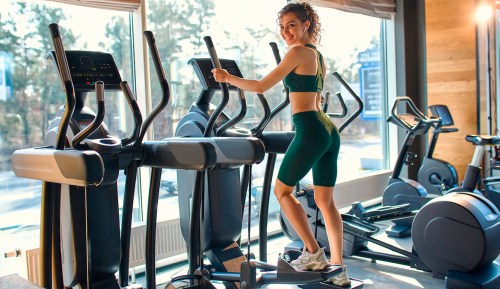Why Does My Face Get So Much Redder Than Everyone Else’s When I Work Out?
If you always have a red face after exercise, there's an explanation for that—and a solution. Here, dermatologists tell all.

When I work out, sweat and a bright red face typically go hand-in-hand. At this point, I’ve just accepted that I’m going to look like a tomato anytime I get my heart rate up. But I have to admit, I am curious… Why am I the only one in my class who seems to experience a red face after exercise?
Experts in This Article
board-certified dermatologist and clinical instructor of dermatology at Weill Medical College of Cornell University
board-certified dermatologist and assistant clinical professor of dermatology at Mount Sinai School of Medicine
New York-based board-certified dermatologist and founder, director, and dermatologic surgeon at Spectrum Skin and Laser
North Carolina-based dermatologist
To get to the bottom of my facial redness—and to give you solace should you live with the same complexion concern—I reached out to the folks who understand skin best: dermatologists.
Ahead, learn why it’s actually common to look flushed post-workout, how to soothe the inflammation, and when you should actually be concerned about a red face after exercise.
Why is my face so red after exercise?
“Getting a red face while working out is completely normal—this is our body’s natural response to regulating temperature,” says Sheel Desai Solomon, MD, a North Carolina-based dermatologist. “As we exercise, blood is being pumped through our blood vessels, or capillaries, at a faster rate to maximize oxygen intake. The capillaries widen to deliver more oxygen to the working muscles and also push heat to the surface of the skin to avoid overheating. This can lead your face to appear red and is especially visible in people with fair skin.”
Fair skin definitely checks out in my case. But the reason you might always be so much redder than your workout pals goes beyond skin tone.
“If you’re someone who gets redder than others, this could be because you have more capillaries in your face than others who have a light pink glow,” Dr. Solomon explains. “Other causes for facial redness can be skin conditions such as rosacea, alcohol use, certain foods, and different medications.”
Additionally, board-certified dermatologist Hadley King, MD, says “for some people, exercise can trigger [the] release of histamine by cells in the skin, which increases peripheral vasodilation—the widening of the small blood vessels found in the skin so that more blood is carried through them.”
No matter what the reason behind your redder-than-normal post-workout complexion may be, you don’t have to go through life basking in that overly bright glow. Instead, use these expert-backed tips to give your skin some relief.
How to neutralize intense facial redness post-exercise
1. Splash or spray your face with cold water during a workout
Instead of scrolling through your phone mid-workout as a break, splash some water on your face to help combat redness.
“This is a great tip to prevent facial redness after a workout altogether,” Dr. Solomon says. “During your workout, spray or splash cold water on your face to help your body cool down and calm down circulation. The sweat you produce when you exercise is already trying to do this for you, but a splash of cold water will take this cooling process one step further.”
(Psst: Taking a cold shower after your workout can help, too!)
2. Use a cold compress and moisturizer after a workout
Aside from extra hair ties and deodorant, consider packing a washcloth in your workout bag. Your skin will thank you for it.
“Applying a cold, damp washcloth to your face after exercising will alleviate tightness around the skin and reduce redness before cleansing your face,” Dr. Soloman says. “Follow this up with a gentle paraben-free moisturizer that will nourish the skin and help soothe inflammation.”
3. Use a cleansing wipe
The next time you’re shopping, make a quick stop by the skin care aisle to pick up a pack of cleansing wipes.
“There are a lot of great cleansing wipes on the market right now to help reduce redness and refresh the skin post-workout,” Dr. Soloman says. “Wiping your face with an aloe vera-based cleansing wipe will help calm everything down and prevent further irritation.”
4. Avoid alcohol and spicy foods
It’s not just your workouts that are causing facial redness—it’s also what you do after you leave the gym.
“If you want to reduce facial redness, it’s essential to avoid things that may cause or aggravate inflammation,” Dr. Soloman says. “Excess alcohol can trigger the same response in your blood vessels when you workout, causing inflammation to become visible on your skin—especially your face. The same goes for spicy foods. They dilate the capillaries under your skin, thus making facial redness more noticeable.”
5. Add aloe vera to your skin care routine
Having aloe vera-infused cleansing wipes can help combat redness after working out, but adding the soothing plant into your daily routine can do wonders, too.
Facial redness is usually an indicator of inflammation or irritation, so lathering on some aloe vera or aloe-based moisturizer can aid in reducing its appearance,” Dr. Soloman says. “Its healing properties help to reduce redness, replenish the skin, and promote cell growth. If you’re someone who blushes more than most, I suggest using aloe vera on the skin daily.”
6. Try not to exfoliate too often
Yeah, yeah—exfoliating makes your skin feel amazing. Unfortunately, if you deal with facial redness regularly, it’s best to keep it to a minimum.
“Exfoliating is a great way to rid your face of dead skin, but it’s easy to go overboard,” Dr. Soloman says. “If you’re prone to redness or you have sensitive skin, exfoliate your skin sparingly and stick to chemical exfoliants.”
7. Grab the hydrocortisone cream
If your facial redness won’t budge, you might have to bring in the big guns. And by that I mean hydrocortisone cream.
“A hydrocortisone topical steroid cream is used to treat redness, swelling, and other irritating skin conditions,” Dr. Soloman explains. “Apply a small amount of an over-the-counter 1 percent hydrocortisone steroid to the affected areas daily to see visibly less red skin.”
8. Try laser or light therapy
While natural treatments are great, you can also combat facial redness with laser or light therapy. It only takes a couple treatments to see results.
“Laser or light therapy can help reduce the visibility of blood vessels, redness, and thickening skin. The vascular laser wavelengths target the blood vessels and increase the heat, causing them to break down and disintegrate, all the while promoting repair and collagen growth,” Dr. Soloman says. “Patients can see between a 50 to 75 percent decrease in the appearance of redness in just after the first two treatments. The pulse dye laser, such as the VBeam laser, is an excellent treatment option for someone with mild to moderate rosacea or chronic facial redness.”
“Getting a red face while working out is completely normal—this is our body’s natural response to regulating temperature.” —Sheel Desai Solomon, MD
How to prevent post-workout redness
While those techniques help to soothe a red face after exercise, there are actually ways to prevent extreme flushing to begin with.
“I recommend drinking plenty of water during exercise that is supplemented with electrolytes to avoid dehydration, especially during sweating,” Dr. Soloman shares. She also suggests avoiding working out in extreme heat. “If you can, work out next to a fan or have a cold washcloth on hand,” she adds.
Another tip? Dress appropriately. According to Dr. King, wearing breathable fabrics will help prevent your body from overheating, which will make a flushed face less likely.
Meanwhile, if you develop face redness during exercise as a result of a histamine disorder, Dr. King says that taking an oral antihistamine can help.
FAQ
1. Why do some people get a white ring around their mouth while working out?
If you experience extreme workout-induced face redness, there’s a good chance that you’ve noticed a white ring around your mouth, too—particularly following intense exercise, such as running or HIIT. (Low-intensity cardio is less likely to cause a flush.) As with redness, this white ring is typically nothing to worry about.
“A white ring around your mouth after exercise is also a common manifestation of the immediate reactions our bodies have to physical exercise,” says board-certified dermatologist Jeannette Graf, MD, assistant clinical professor of dermatology at Mt. Sinai School of Medicine. “The white ring is most common from dehydration that occurs during exercise. When you become dehydrated, your saliva can become thicker, sticky, and white in color leading to a white ring around the mouth during exercise. Another cause is dry mouth, which can commonly occur during exercises like running where people are breathing more heavily through their mouths.”
According to Dr. King, the ring—which is referred to as the “white roll”—is also determined by the muscle fibers and blood vessels that lay beneath the skin.
“The ‘white roll’ is a 2- to 3-millimeter pale convexity that outlines the lips,” she says. “It is formed by muscle fibers beneath the skin. This area will not become as red as other areas when peripheral vasodilation occurs because the density of superficial blood vessels here is lower.”
2. How long should post-workout redness occur?
According to Jeremy Brauer, MD, New York-based board-certified dermatologist and founder, director, and dermatologic surgeon at Spectrum Skin and Laser, post-workout redness shouldn’t last more than 30 minutes, as it should subside as your heart rate and blood pressure return to baseline.
“If yours persists, it may be a sign of rosacea, and you should consult a dermatologist,” he says.
3. When should you consult a doctor about a red face post-workout?
If your face maintains a rich flush hours after working out, Dr. Graf says to seek medical attention. If your skin merely looks red, a dermatologist is worth consulting, as they will be able to determine what’s causing your complexion to react in such a way—and how to treat it.
That said, if your skin looks red and you feel physically unwell, reaching out to your GP is a good idea. And if it feels emergent, call 911.
The takeaway
And now you know! The next time you experience a flushed face after a workout, there’s no need to worry.
“As we work out, our blood flow increases, and our bodies go through vascular changes,” Dr. Graf reminds us. “This is a perfectly safe and common reaction to physical exercise and is how our bodies react to the heat we generate during exercise.”
And the paler your skin, the more visible the redness will be.
Now, if along with facial flushing during fitness you physically feel unwell, then you may have something to worry about.
“If your red face is accompanied by symptoms like a dry mouth, thirst, and dizziness, this could be a sign of dehydration,” Dr. Brauer says. “If it’s paired with dizziness, nausea, fast or shallow breathing, vomiting, a racing heart, light-headedness, difficulty breathing, or heart palpitations, it may be hypothermia, and you should consult a doctor.”










